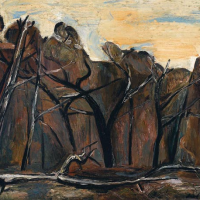55. FRED WILLIAMS

Almost any aspiring artist in mid-century Australia could well have thought that anything worth saying about the landscape had already been said. From the tentative depictions of the convict illustrators, through the romantic topographers and the hybrid Barbizon and orientalist glare painting of the Heidelberg School, every corner of the land had been explored. The tonal realists held sway for decades, to be overpowered by the modernists, led by Arthur Boyd (1920-1999), Sidney Nolan (1917-1992) and Albert Tucker (1914-1999). At times the land was empty, but more often than not peopled by hardy farmers, explorers, lonely outback women, desperate bushrangers and vast flocks of sheep. The Australian imagination and psyche had been fed by an endless supply of images, designed to awaken the land to a largely urban population. But in five short years in the early 1960s, one artist not only reinvented the way the landscape was painted, but was able to educate the people in a new way of seeing their own land. Looking out the window of a speeding car on the Hume highway, or winding through the shadowed glades of the Dandenongs, we began to see the view in terms of a Fred Williams painting. Commuters driving to and from Geelong would suddenly see the You Yangs, not just as a marker of the half-way point on the road, but as a special, magic place whose secret had been unlocked by Williamss vision. In the same way that travellers on the Calder Highway cannot pass Hanging Rock without a frisson of disquiet at the fate of Peter Weirs lost schoolgirls, the rocky outcrop thrust up from the flat plain has become an almost spiritual place, thanks to one artists vision.
The works created by Williams are all the more remarkable because he did not grow up with any close affinity with the bush, instead being the product of an urban upbringing in the inner Melbourne suburb of Richmond. From an early age he was determined to become an artist and worked assiduously to gain the skills required. He studied at the conservative National Gallery School, followed by a period at the more enlightened George Bell School. Too young for service in the second World War, soon after the conflict was over he took himself to England to continue his art education. He was in no rush to get out into the hurly burly of the commercial art world, preferring to master the core disciplines of the painter and printmaker. By the time he returned to Australia in 1956 he had learned from the best teachers in London and had absorbed as much as he could from the great art of the past. His English work was almost exclusively centred on the figure, but from the moment he landed back in Australia he was drawn to the landscape and the special light of his homeland.
Williamss approach to the landscape was quite unlike any of his predecessors. He didnt scour the countryside for the picturesque and the romantic, seeking out the scenic outlooks and the popular vistas. He simply went out to the nearest bit of bush on the outskirts of town and drew the picture from whatever was in front of him. He saw the bush for what it was, the scrappy, messy tangle of trees, scrub, rocks and fallen branches. He was not drawn to Streetons vision splendid, but was happy with whatever place he happened to stop. He travelled often to the nearby Dandenong Ranges, just to the East of Melbourne. The steep hills, fern gullies and tall timber had attracted artists since Victorian times, but Williams took a very different view. Sitting close in to the bush, he saw the mess of saplings and rocks, often without an horizon, and answered with a series of marks, lines and squiggles of abstract simplicity, but perfectly descriptive and recognisable.
Fallen Tree comes just three years after Williams returned to Australia and presents with fresh simplicity his engagement with the bush. It shows an artist still finding his voice, but in a work that has all the hallmarks of his best work. The forest itself is backgrounded as a dark and impenetrable mass, pushing up against the tangle of burned trees that mark the middle ground. Williams quite deliberately breaks the rules of traditional landscape, putting the dominant form squarely in the middle of the picture, flanked by more blackened trunks. There is no elegant structure as one might find in a Penleigh Boyd (1890-1923) painting of the same place, but an image wrenched from the struggling bush, hanging on in the face of fire and the depredations of man. Simple works such as this would lead to some of the most important landscapes ever painted in this country, a body of work that brought the artist worldwide admiration and fame.
Gavin Fry BA[Hons], MA, M.Phil